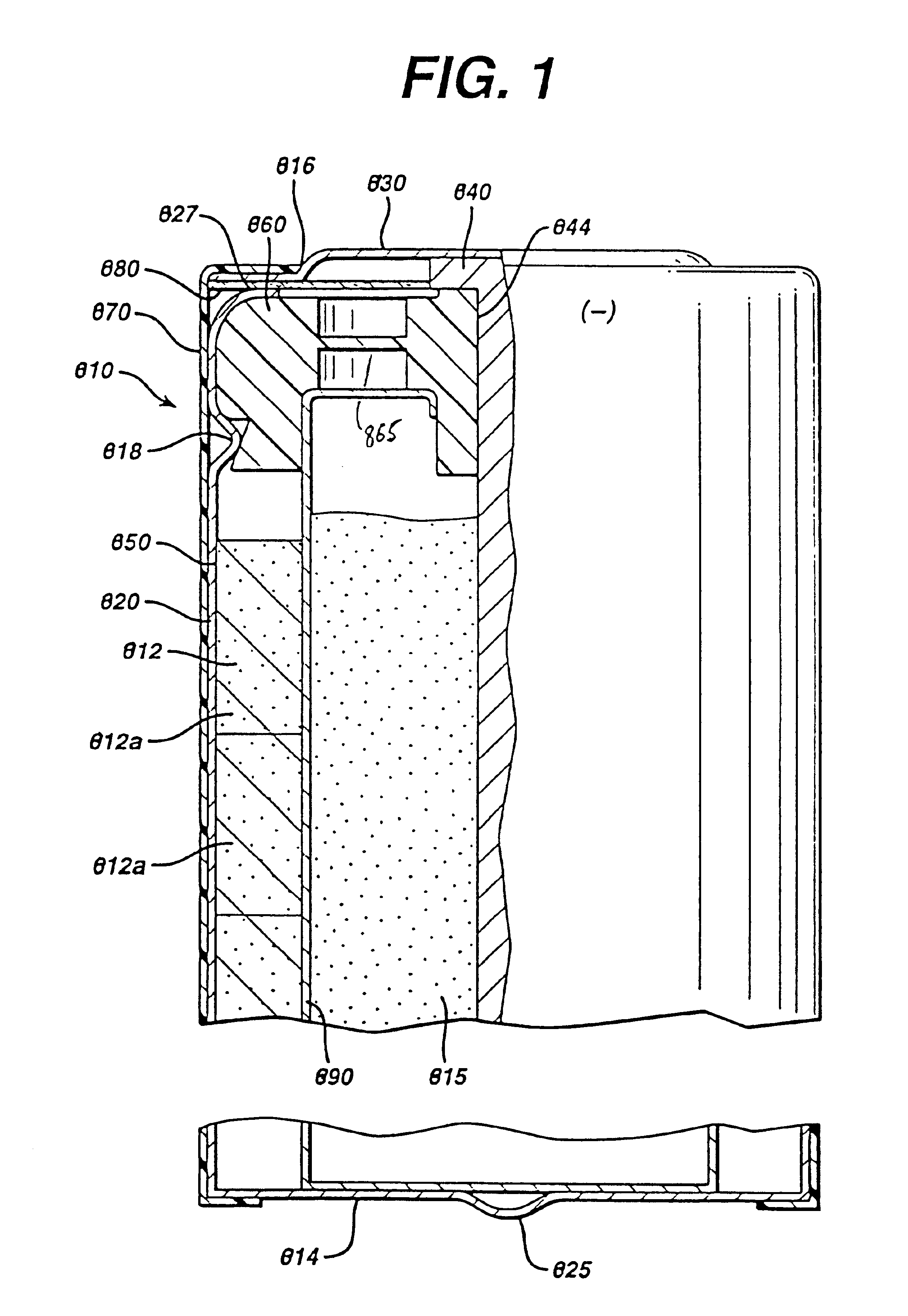Alkaline cell with improved cathode
a cathode and alkaline technology, applied in the direction of positive electrodes, cell components, electrochemical generators, etc., can solve the problems of increasing reducing cathode resistance, and lowering cell running voltage, so as to reduce cathode resistance, and increase cell capacity and performance
- Summary
- Abstract
- Description
- Claims
- Application Information
AI Technical Summary
Benefits of technology
Problems solved by technology
Method used
Image
Examples
example 1a
Comparative—Zinc Anode; MnO2 Cathode with Natural Graphite
Test cylindrical cells 110 were prepared. The cell 10 had an overall dimension of about 15 mm diameter and depth of about 8.2 mm. The total internal volume of cell 110 available for cathode 170 and anode 150 was about 1.2 cubic centimeters. Test cells 110 were prepared with a anode 150 comprising Zinc alloy powder 62 to 69 wt % (99.9 wt % zinc containing indium), an aqueous KOH solution comprising 38 wt % KOH and about 2 wt % ZnO; a cross-linked acrylic acid polymer gelling agent available commercially under the trade name “CARBOPOL C940” from B. F. Goodrich (e.g., 0.5 to 2 wt %) and a hydrolyzed polyacrylonitrile grafted onto a starch backbone commercially available commercially under the tradename “Waterlock A-221” from Grain Processing Co. (between 0.01 and 0.5 wt. %); dionyl phenol phosphate ester surfactant available commercially under the tradename “RM-510” from Rhone-Poulenc (50 ppm). The zinc alloy average particle si...
example 1b
Comparative Zn Anode; MnO2 Cathode with Expanded Graphite
The same cell as in Example 1A was prepared except that the natural graphite in the cathode was replaced with expanded graphite. The cathode composition was as follows:
Cathode Composition1Wt. %Vol. %MnO2 (EMD)87.672.2(Trona D)Expanded graphite25.59.0(WH20)KOH aqueous6.517.5Solution (38 wt %KOH and 2 wt % ZnO)Polyethylene0.41.3Binder100.0100.00Notes: 1The wt. % values have been converted from vol. % using the following real densities: MnO2 (EMD), 4.45 g / cc; natural graphite (2.25 g / cc); and 38 wt % KOH aqueous solution (1.37 g / cc). 2Expanded graphite WH20 from Chuetsu Company.
The cell 110 is discharged at a constant rate of 22 milliAmp to a cut off voltage of 0.1 volts. This is equivalent to a current density of about 21 milliAmp / cm2 based on the anode / cathode interface, approximately equivalent to a constant current discharge of about 250 milliAmp in a AA size cell as in FIG. 2. The cell had a time averaged running voltage of...
example 1c
Comparative Zn Anode; MnO2 Cathode with Graphitic Carbon Nanofibers
The same cell as in Example 1A was prepared except that the natural graphite in the cathode was replaced with graphitic carbon nanofibers. The cathode composition was as follows:
Cathode Composition1Wt. %Vol. %MnO2 (EMD)87.672.20(Trona D)carbon nanofibers25.59.00(NdG-15)KOH aqueous6.517.50Solution (38 wt %KOH and 2 wt % ZnO)Polyethylene0.41.30Binder100.0100.00Notes: 1The wt. % values have been converted from vol. % using the following real densities: MnO2 (EMD), 4.45 g / cc; natural graphite (2.25 g / cc); and 38 wt % KOH aqueous solution (1.37 g / cc). 2Graphitic carbon nanofiber from Applied Sciences, Cedarville, Ohio., post heat treated at temperatures of between about 2500° C. and 3100° C. The fibers had an average diameter of 200 nanometer and average length of 200 micron.
The cell 110 was discharged at a constant rate of 22 milliAmp to a cut off voltage of 0.1 volts. This rate is equivalent to a current density of abo...
PUM
 Login to View More
Login to View More Abstract
Description
Claims
Application Information
 Login to View More
Login to View More - R&D
- Intellectual Property
- Life Sciences
- Materials
- Tech Scout
- Unparalleled Data Quality
- Higher Quality Content
- 60% Fewer Hallucinations
Browse by: Latest US Patents, China's latest patents, Technical Efficacy Thesaurus, Application Domain, Technology Topic, Popular Technical Reports.
© 2025 PatSnap. All rights reserved.Legal|Privacy policy|Modern Slavery Act Transparency Statement|Sitemap|About US| Contact US: help@patsnap.com


